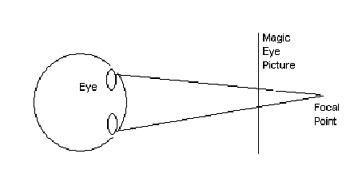

The
Magic Eye
Yun
Hwang
Have you ever gazed into a piece of paper
with a series of seemingly random dots but focused into
the distance? This picture of random dots, of course,
is a ‘Magic Eye’ picture. When you follow the instruction
and focus in the distance, magically, you see a three-dimensional
image (3D) on a two-dimensional (2D) sheet of paper.
Like most magic, creating a 3D image is
done in a very clever fashion. What is different about
this ‘magic’ is that there is no deception involved; the
‘magic’ effect is a very simple manipulation of how you
use your eyes to generate depth perception.
There are two ways that your brain processes
the 2D visual image into a 3D picture. One way is through
learning and deducting from past experiences. For instance,
if you see a car behind a person, your brain assumes that
there is a car behind the person. Or if you see a car
and a house that are the same size, your brain assumes
that the house is farther away than the car, since your
past experience tells you that a house should be larger
than the car. This deduction from past experience is a
basis for many optical illusions, such as ‘The Shrinking
Room’, where the room looks much longer than it actually
is because certain objects are smaller than they should
be according to the brain.
This method is not really usable on a
single sheet of paper. Instead, Magic Eye pictures employ
a method that is hard-wired into your brain. Each eye
creates a visual field that corresponds to what it sees.
This visual field is what you see when you close one eye
and look at the world through the other one eye. Because
we have two eyes located on a slightly different place
on the face – the difference is only minor, but that is
sufficient – each eye’s visual field is different from
that of the other.
 |
A simple demonstration: put your finger in front of your nose; now cover one eye and look at the finger noticing where the finger is in relation to the background. Now, cover the other eye and look at the finger. The finger should be in a different place relative to the background.
Focusing on one object and comparing the degree of discrepancy between the two visual fields allows the brain to judge the distance from the object.
Want to give it a go? Click here to view our stereogram in a new window.
The clever ‘trick’ in the Magic Eye pictures is that you focus on a point that is behind the Magic Eye picture you are looking at. By putting a Magic Eye picture before the focal point (see diagram), you effectively present two different images of the Magic Eye picture in your left and right eye. Your brain interprets the differences as a 3D image. Which just goes to show – you can’t be cool without science.
Still
having trouble seeing the letters? Click
here for the answer.
See OnSET's Visualising
the tesseract
OnSET is an initiative of the Science Communication Program
URL: http://www.onset.unsw.edu.au/ Enquiries: onset@unsw.edu.au
Authorised by: Will Rifkin, Science Communication
Site updated: 7 Febuary, 2006 © UNSW 2006 | Disclaimer
OnSET is an online science magazine, written and produced by students.
![]()
OnSET Issue 6 launches for O-Week 2006!
![]()
Worldwide
Day in Science
University
students from around the world are taking a snapshot
of scientific endeavour.
Sunswift
III
The UNSW Solar Racing Team is embarking
on an exciting new project, to design and build the
most advanced solar car ever built in Australia.
![]()
Outreach
Centre for Sciences
UNSW Science students can visit your school
to present an exciting Science Show or planetarium
session.
![]()
South
Pole Diaries
Follow the daily adventures of UNSW astronomers
at the South Pole and Dome C through these diaries.
News in Science
UNSW is not responsible for the content of
these external sites